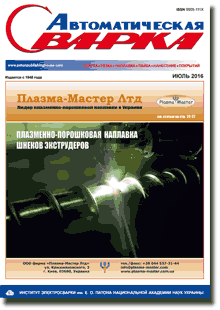| 2016 №07 (01) |
DOI of Article 10.15407/as2016.07.02 |
2016 №07 (03) |

Avtomaticheskaya Svarka (Automatic Welding), #7, 2016, pp. 9-17
Application of electrodynamic treatment with amplitude-frequency control of current pulses for life extension of aircraft structures of light alloys
L.M. Lobanov1, N.A. Pashchin1, O.L. Mikhoduj1, A.V. Cherkashin1, A.V. Zarutsky2 and I.P. Kondratenko3
1E.O. Paton Electric Welding Institute, NASU 11 Kazimir Malevich Str., 03680, Kiev, Ukraine. E-mail: office@paton.kiev.ua
2N.E. Zhukovsky National Aerospace University «KhAI» 17 Chkalov Str., Kharkov, Ukraine
3Institute of Elecrodynamics, NASU 56 Pobeda Ave., 03057, Kiev, Ukraine
Abstract
The pulsed electric current (PEC) generator of a new generation with the controlled amplitude-frequency characteristics of PEC for electrodynamic treatment (EDT) of thin-sheet metal structures was designed and manufactured. The use of a new class of equipment allows a significant extension of capabilities of electrodynamic effects due to the controlled synchronization of the EDT dynamic and electric pulse components. The effect of EDT on reducing the level of residual welding stresses in magnesium alloy ML10 joints was investigated. As the investigated specimens the fragments of the shell of the intermediate body of the aircraft engine D-36 containing repair welds were used. It was found that EDT allows reducing the level of residual welding stresses from 120 to –40 MPa, providing their transition from tensile to compressive ones. It is shown that the local plastic deformation applying EDT of specimens of an aircraft wing stringer of aluminum alloy D16 in the area of technological holes 1.6–2.5 times increases the resistance to a delayed fracture. 9 Ref., 2 Tables, 14 Figures.
Keywords: electrodynamic treatment, electric current pulse, aircraft structures, residual stresses, repair welding, body of aircraft engine, stringer, technological hole
Received: 22.12.15
Published: 02.08.16
References
- Shalomeev, V.A., Tsivirko, E.I., Petrik, I.A. et al. (2009) Welding repair of surface defects in ML-10 alloy castings by using scandium-containing material. The Paton Welding J., 3, 23–27.
- Lobanov, L.M., Pashchin, N.A., Cherkashin, A.V. et al. (2012) Repair welding of intermediate cases of aircraft engines from high-temperature magnesium alloy ML 10 with application of electrodynamic treatment. Ibid., 11, 28–33.
- Lobanov, L.M., Pashchin, N.A., Savitsky, V.V. et al. (2014) Study of residual stresses in welded joints of high-temperature alloy ML10 with application of electrodynamic treatment. Problemy Prochnosti, 6, 33–41.
- Zarutsky, A.V. (2014) Experimental study of service life of specimens with strengthened holes. Information 2: Software loading. In: Problems of design and manufacturing of aircraft structures: of KhAI, Issue 2(78), 57–65.
- Lobanov, L.M., Pivtorak, V.A., Savitsky, V.V. (2006) Procedure for determination of residual stresses in welded joints and structural elements using electron speckle-interferometry. The Paton Welding J., 1, 24–29.
- Lobanov, L.M., Pashchin, N.A., Loginov, V.P. et al. (2007) Change of the stress-strain state of welded joints of aluminium alloy AMg6 after electrodynamic treatment. Ibid., 6, 7–14.
- Grebenikov, A.G., Krivov, G.A., Vasilevsky, E.T. (2009) Experimental study of influence of subsequent application of boring mandrelling and barrier compression on fatigue life of stringers in zone of fuel crossfeed hole. In: Open information and computer integrated technologies: of KhAI, Issue 43, 54–64.
- Gushcha, O.I., Smilenko, V.N., Kot, V.N. (2009) Control of stresses on the base of application of subsurface acoustic waves. Diagnostika i Nerazrush. Kontrol, 1, 11–13.
- Fomichev, P.A., Zarutsky, A.V. (2014) Prediction of service life of structure elements with strengthened holes under regular loading. In: Open information and computer integrated technologies: of KhAI, Issue 64, 84–93.
